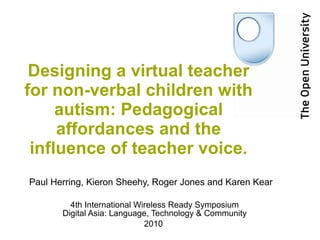Sheehy Et Al 4th International Wireless Ready Symposium (1)
- 1. Paul Herring, Kieron Sheehy, Roger Jones and Karen Kear 4th International Wireless Ready Symposium Digital Asia: Language, Technology & Community 2010 Designing a virtual teacher for non-verbal children with autism: Pedagogical affordances and the influence of teacher voice.
- 2. Children with Autism qualitative impairment in social interaction, qualitative impairments in communication delay in, or total lack of, the development of spoken language restricted repetitive and stereotyped patterns of behaviour, interests and activities Eighty per cent will have profound or severe learning difficulties. Within this group, approximately one-third to one-half of these children will lack functional speech (Mirenda 2003)
- 3. Pedagogies and Approaches Behavioural: Applied Behaviour Analysis, Lovaas, SCAmp Environmental : TEACCH, Daily Life Therapy Social Interaction : Intensive Interaction, Technological : virtual worlds (Bignell, 2008) and socially intelligent agents (Dautenhahn and Werry, 2004).
- 4. The Picture Exchange Communications System An augmentative & alternative communication (AAC) approach For children with little or no speech to develop language and communication skills. E xchanging pictures and symbols for desired items or outcomes. There is empirical evidence to support the value of this approach (Preston and Carter, 2009).
- 5. New technologies and new teacher embodiment (Sheehy, 2010) Virtual and augmented. Degrees of artificial intelligence
- 6. Computer Assisted Picture Exchange ( CAPE ). Non-verbal children Bridging virtual and real spaces Utilising PECS pedagogy Developmental iterative research approach. based on the Center of Spoken Language Understanding toolkit (University of Oregon) , Radio Frequency Identification (RFID) enabled input and BoardMaker symbols (Mayer-Johnson LLC).
- 7. The question of ŌĆśvoiceŌĆÖ Williams (2004) - Computer Assisted Learning (CAL) to support reading for children with autism. children found the voices they used ŌĆśtoo syntheticŌĆÖ, however this aspect was not subsequently explored further. This implies an apparent mismatch between preference for particular (non-human) appearance and the associated voice. This study looked at Natural voice vs. synthetic voice distinction, in the context of CAPE.
- 8. Task 1: Help Super Monkey? The child sees three foods and one drink item is advised that the virtual tutorŌĆÖs friend, Super Monkey had not eaten today asked to choose a food or drink item for Super Monkey from the symbols provided
- 9. Help Super Monkey The child affixes the symbol to the communication board and the RFID reader Symbol selection is confirmed by the virtual tutor and a digital representation on- screen Super Monkey consumes the food or drink.
- 10. Would you like to continue?
- 11. Task 3: Verbal Request only
- 12. Experimental design Related, two condition, counterbalanced design. Eight participants, with a formal diagnosis of autism, 7-10 years, who use a maximum of one word utterance. virtual teacher spoke with either a female human voice or synthetic generated voice. The two teaching sessions of ten minute duration were spaced across four days Quantitative and qualitative data was collected.
- 13. Quantitative measures How many symbols were selectedelected appropriately? The total time spent looking at the computer screen and the symbols. The total time spent looking at the teacher in the room. The average speed of response to the virtual teachers requests. The average speed of response to verbal requests from the virtual tutor that with and without a visual prompt.
- 14. Coding using fOCUS III software
- 15. No significant differences between natural vs. synthetic conditions on any measure. However, significant differences were noted in the overall comparisons for Auditory and visual cue vs. Auditory cue task. [natural voice] Supports the use of visual symbols approach with this group of children?
- 16. Qualitative observational data The initial verbal greeting by the virtual tutor of ŌĆ£helloŌĆØ and animation of Super Monkey. Modelling of initial symbol selection Participant 2 and avatar eye contact aversion vs. others engagement. Children had different interests Teacher interviews re natural vs synthetic.
- 17. Conclusions Pilot study raise many aspects for further research and development. Joint attention Eye contact and screen analysis. Developing the pedagogy Teacher attitudes
- 18. References Bignell, s. (2008) Social communication skills of people diagnosed with autism in 3D multi- user virtual worlds. Realive08 Milton Keynes, England. Dautenhahn, K. & Werry I. (2004) Towards Interactive Robots in Autism Therapy: Background, Motivation and Challenges. Pragmatics and Cognition 12(1), pp. 1-35. Mirenda, P. (2003) Toward functional augmentative and alternative communication for students with autism: Manual signs, graphic symbols Language, Speech, and Hearing Services in Schools 34 , 2, 203 Preston, D. & Carter, M. 2009 A Review of the Efficacy of the Picture Exchange Communication System Intervention Journal of Autism and Developmental Disorders 39, 10, 1471-1486 Sheehy, K. (2010). Inclusive education and virtual worlds: The Teacher Embodiment And LEarning Affordance Framework (TEALEAF). In Virtual Worlds: Controversies at the Frontier of Education. Nova Science Publishers Williams, C. Wright, B. Callaghan, G. Coughlan, B. (2002). "Do children with autism learn to read more readily by computer assisted instruction or traditional book methods? A pilot study." Autism 6(1): 71-91.
Editor's Notes
- #11: The aim of task 2 is to teach the ŌĆśYesŌĆÖ and ŌĆśNoŌĆÖ symbols to the participant and to introduce them to communication partner initiated questions to understand if they would like an item or take part in an activity















![No significant differences between natural vs. synthetic conditions on any measure. However, significant differences were noted in the overall comparisons for Auditory and visual cue vs. Auditory cue task. [natural voice] Supports the use of visual symbols approach with this group of children?](https://image.slidesharecdn.com/sheehyetal4thinternationalwirelessreadysymposium1-12670204284998-phpapp01/85/Sheehy-Et-Al-4th-International-Wireless-Ready-Symposium-1-15-320.jpg)


